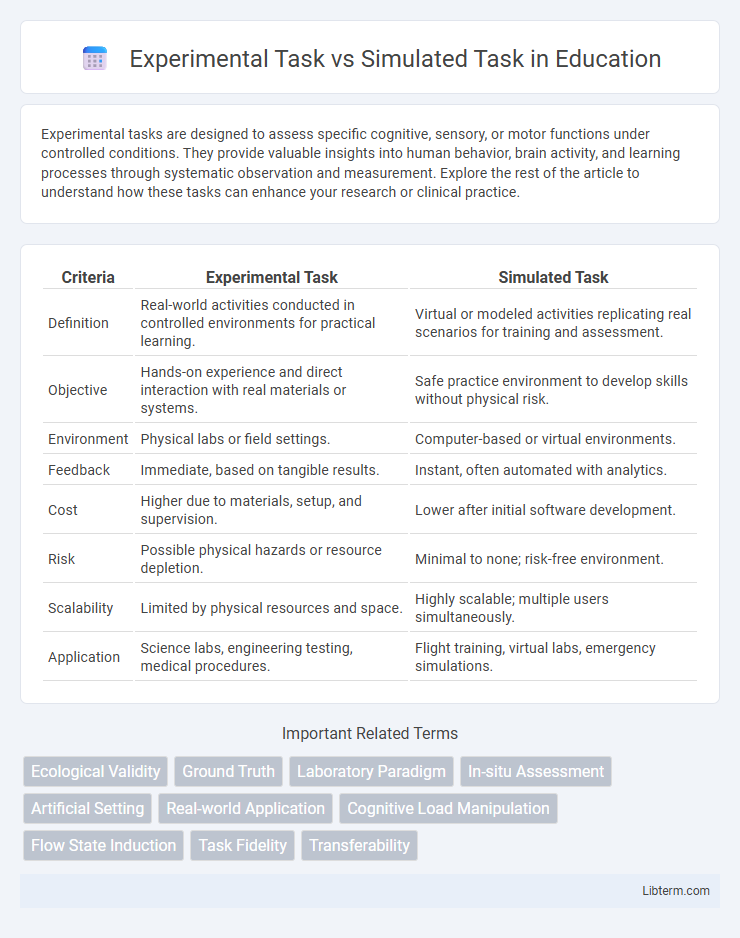Experimental tasks are designed to assess specific cognitive, sensory, or motor functions under controlled conditions. They provide valuable insights into human behavior, brain activity, and learning processes through systematic observation and measurement. Explore the rest of the article to understand how these tasks can enhance your research or clinical practice.
Table of Comparison
| Criteria | Experimental Task | Simulated Task |
|---|---|---|
| Definition | Real-world activities conducted in controlled environments for practical learning. | Virtual or modeled activities replicating real scenarios for training and assessment. |
| Objective | Hands-on experience and direct interaction with real materials or systems. | Safe practice environment to develop skills without physical risk. |
| Environment | Physical labs or field settings. | Computer-based or virtual environments. |
| Feedback | Immediate, based on tangible results. | Instant, often automated with analytics. |
| Cost | Higher due to materials, setup, and supervision. | Lower after initial software development. |
| Risk | Possible physical hazards or resource depletion. | Minimal to none; risk-free environment. |
| Scalability | Limited by physical resources and space. | Highly scalable; multiple users simultaneously. |
| Application | Science labs, engineering testing, medical procedures. | Flight training, virtual labs, emergency simulations. |
Introduction to Experimental and Simulated Tasks
Experimental tasks involve real-world activities conducted in controlled environments to observe genuine human behavior and physiological responses. Simulated tasks replicate these activities using virtual or computer-generated scenarios, enabling safe, repeatable, and scalable assessments. Both methods provide critical insights for research and training but differ in ecological validity and control over extraneous variables.
Defining Experimental Tasks
Experimental tasks are structured activities designed to systematically manipulate and measure specific variables under controlled conditions, enabling precise observation of cause-and-effect relationships. These tasks often involve real-time interaction with stimuli to assess cognitive, behavioral, or physiological responses, distinguishing them from simulated tasks that replicate real-world scenarios without direct experimental control. Defining experimental tasks requires careful consideration of task complexity, variable manipulation, and reproducibility to ensure valid and reliable data collection in research settings.
Understanding Simulated Tasks
Simulated tasks replicate real-world scenarios in a controlled environment to study behavior, decision-making, and skill acquisition without the risks or constraints of experimental tasks. These tasks use advanced modeling and virtual reality technologies to create immersive experiences that maintain ecological validity while allowing precise manipulation of variables. Understanding simulated tasks enhances the development of training programs and cognitive research by providing rich, reproducible data that mirrors complex human interactions.
Key Differences Between Experimental and Simulated Tasks
Experimental tasks involve real-world environments or live participants performing specific actions under controlled conditions, generating empirical data. Simulated tasks replicate real scenarios through virtual or computer-generated models, allowing manipulation of variables without physical constraints. Key differences include the level of ecological validity, control over extraneous factors, and the type of data collected--direct observation versus virtual performance metrics.
Advantages of Experimental Tasks
Experimental tasks provide direct control over variables, enabling precise measurement of participant responses and causal inference. They facilitate real-time data collection in controlled environments, reducing confounding factors and enhancing internal validity. This approach often produces more reliable and replicable results compared to simulated tasks, which may lack ecological validity.
Benefits of Simulated Tasks
Simulated tasks offer enhanced control over variables, allowing for consistent and repeatable testing environments that reduce external biases common in experimental tasks. They enable safe assessment and training in high-risk scenarios without real-world consequences, improving learning outcomes and performance accuracy. Furthermore, simulated tasks facilitate cost-effective experimentation by minimizing resource expenditure and allowing rapid scenario adjustments to optimize skill acquisition.
Limitations of Each Approach
Experimental tasks often face limitations such as lack of ecological validity, as tightly controlled environments may not accurately reflect real-world conditions. Simulated tasks, while providing safer and more flexible testing scenarios, can suffer from artificiality and may fail to capture complex situational nuances. Both approaches may struggle with generalizability, impacting the applicability of findings across diverse populations and settings.
Applications in Research and Industry
Experimental tasks are crucial in research for directly observing and measuring real-world behaviors under controlled conditions, enabling precise data collection and hypothesis testing. Simulated tasks offer scalable, cost-effective solutions for industry applications by replicating complex environments using virtual models, allowing for risk-free experimentation and training. Combining both methods enhances innovation in fields such as cognitive psychology, robotics, and manufacturing by balancing ecological validity with experimental control.
Choosing the Right Task Type
Selecting the appropriate task type depends on the research objectives and practical constraints; experimental tasks offer controlled environments to test specific hypotheses with real participant interactions, while simulated tasks provide flexibility to model complex scenarios and predict outcomes without real-world risks. Experimental tasks are ideal for generating empirical data and observing natural behaviors under manipulated variables, whereas simulated tasks excel in exploring theoretical models and conducting cost-effective trial runs. Prioritizing the task that aligns with the desired data validity, resource availability, and ethical considerations ensures optimal study design and meaningful results.
Future Trends in Task-Based Experimentation
Future trends in task-based experimentation emphasize integrating augmented reality and machine learning to enhance the realism and adaptability of both experimental and simulated tasks, offering personalized and context-aware scenarios. Advances in neurotechnology promise more precise measurement of cognitive and behavioral responses during tasks, enabling dynamic task adjustments in real time. These innovations aim to bridge the gap between controlled experimental designs and ecological validity, driving forward applications in fields such as cognitive science, human-computer interaction, and rehabilitation.
Experimental Task Infographic

 libterm.com
libterm.com